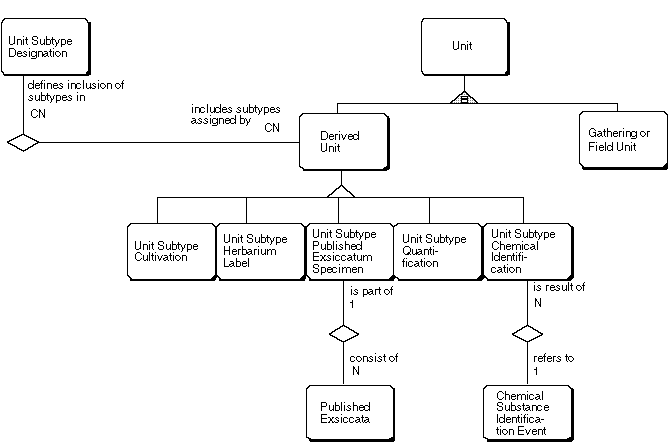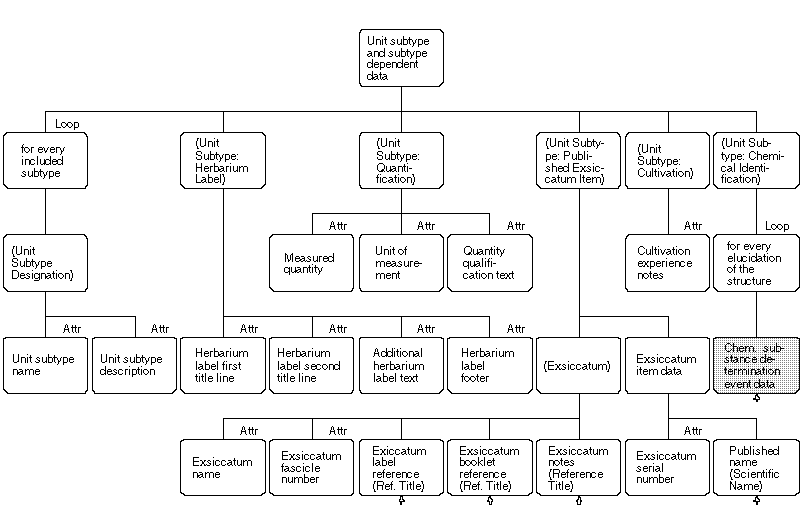

Diagram 18: Derived unit subtypes (Entities)
Units in natural history collections range from palaeontological samples and herbarium specimens to microbial isolates or even chemically pure natural substances. A variety of attributes exist which are specific to only some of these. Subtyping the Unit entity provides a possibility to flexibly assign such attributes. It also allows for the extension of the model to include other types which are not yet considered. This is done by appending the new type to the entity Unit Subtype Designation and adding a new unit subtype entity. A NIL-value subtype designation must be possible for units which are covered entirely by the attributes of the unit supertype.
The entity Unit Subtype Designation consists of a short unit subtype name and a description of the subtype. Several subtypes may be linked to a single unit. Examples:
Unit Subtype Cultivation. Apart from propagation information, which belongs to the derived unit creation methodology, attributes may be needed to alert technical staff on special procedures, or store experience gained with the unit. Normally, a single attribute, cultivation experience notes, will suffice.
The Unit Subtype Herbarium Label contains attributes which may also apply to similar collection labels. The application program may offer to automatically assign values to these attributes from gathering information (e.g. project sponsors as label footer, collector or "Flora of" and country as title, etc.). Other types of collections, especially where very small labels are used (entomological collections) may not need such a subtype at all.
The Unit Subtype Quantification is thought to be useful e.g. in chemical substance collections or in seed banks, where the availability of material may depend on the quantities in store. If measurements are stored, the measurement unit (cm, g, ml, etc.) must be recorded. If the measurement unit is left empty, the quantity is a count (e.g. duplicates in an insect collection, number of vials in a preservation batch of micro-organisms). This is also used to prevent cleptotypification (warning: one of the authors sometimes records the weight before sending types on loan …).
Published Exsiccata play an important role in herbarium collections. They consist of numbered sets of carefully selected duplicate specimens, which are published under an exsiccatum name. Entire sets or individual items are usually distributed to several herbaria and thus serve as reference collections. Publication may occur in numbered fascicles, which may be published in different years and thus are treated as different reference titles in a publication series. Every exsiccatum specimen is a unit with an exsiccatum number, which refers to a specific identification (scientific name). Strictly speaking, the super-subtype relationship between unit and published exsiccatum specimen exists only for the unit in which all materials are still united. However, since it is part of the definition of an exsiccatum that information and material content has to be the same for all duplicates, this information may be copied to all such derived units. After 1953 the publication of a new botanical name in exsiccata is valid only if a separate printed publication is distributed independently of the exsiccatum itself. A second publication reference is supplied for this case (exsiccatum booklet reference). Another reference may be cited to give additional notes on the exsiccatum.

Diagram 19: Examples for unit subtypes
The Unit Subtype Chemical Identification provides an example of a set of attributes which sometimes would be considered descriptors gained in a study. However, for example in a natural substance collection the determination of the structure of a compound is a routine procedure and may even determine the physical arrangement of the collection units in storage. (N.B.: processes like extraction, purification, and isolation belong to the derived unit creation event method.) Analogous "identification subtypes" may be formulated for geological substrate in palaeontological collections, or the soil samples used in the isolation of microbes, etc., always provided that where these units are housed such properties are considered an integral part of the unit data.